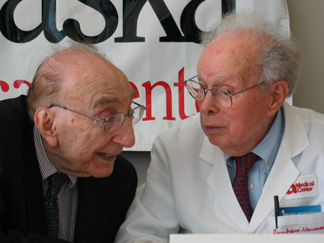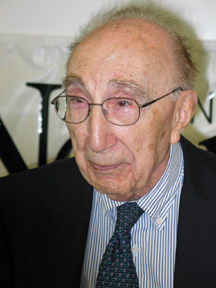 |
Drs. Michael DeBakey, left, and Denham Harman. Photo by Walter Brooks. |
Michael DeBakey, M.D., wanted to buy nylon.
But, the Houston, Texas, department store was “fresh out of nylon,” he said.
Instead, the world-renowned surgeon bought a yard of Dacron, which he fashioned into the first arterial grafts for arteries and blood vessels on his wife’s Singer sewing machine.
“Fate plays a big role in your life,” said Dr. DeBakey, 97, who delivered a lectureship Wednesday (Oct. 5) in honor of UNMC’s Denham Harman, M.D., a pioneer in the theory of aging. Dr. Harman will celebrate his 90th birthday in February.
“Dacron proved to be the right material,” Dr. DeBakey said, noting that a colleague bought nylon at a different department store and spent two years without success.
Fate also guided Dr. Harman, whose theories on aging in the 1950s initially were discounted.
“Life is a series of chances,” Dr. Harman said, noting how he decided to study chemistry instead of aeronautical engineering and how his studies on free-radical atoms at Shell Oil Co., eventually led to his theories on aging – theories which weren’t accepted until the 1980s.
“The research Dr. Harman has done is extremely valuable,” Dr. DeBakey said. “There’s still a lot more we don’t understand and I hope, by chance, you’ll continue to work on it.”
Dr. DeBakey’s career, meanwhile, began when open-heart surgery didn’t exist and many cardiovascular problems were untreatable. Today, his name is widely associated with life-saving surgical techniques.
 |
Dr. Michael DeBakey |
Dr. DeBakey, who has done more than 60,000 surgeries in his career, invented the roller pump that ultimately led to the creation of the heart-lung bypass machine, developed techniques for repairing aortic aneurysms, and the MicroMed DeBakey Ventricular Assist Device (VAD), a miniature device implanted into the heart to increase blood flow for those suffering from congestive heart failure.
Dr. DeBakey said sewing the Dacron graft on his wife’s sewing machine came naturally because his mother was an expert sewer and taught him the art. After two years of making grafts of varying sizes and testing them in animals he decided he was ready to put it in humans. “We didn’t have an IRB (institutional review board),” he said. “I was the IRB.”
The roller pump, he said, was not invented for the heart-lung machine, rather for direct blood transfusions as there were no blood banks. As a medical student, Dr. DeBakey was working as an assistant in a research lab when he was told to develop a pump. His first trip to the library was fruitless, he said.
Then, fate intervened.
A college classmate and friend, who had studied engineering, told Dr. DeBakey: “You went to the wrong library. Go to the school of engineering.”
Dr. DeBakey did and struck gold.
And, of all of Dr. DeBakey’s accomplishments, which stands out? “The last,” he said. “You can’t dwell on these things. Every day is a new day.”
Dr. DeBakey and Dr. Harman are in the office every day, they said. “It’s important to maintain an intellectual challenge,” Dr. DeBakey said. “I’m busy as can be and constantly behind in my work.”
He questions the 80-hour a week mandate for residents saying: “Students learn more if they can follow a patient than an illness and it often takes more than 80 hours a week to do that. If the rule had applied (during my day) they’d have put me in jail. I was there as long as a felt I was needed.”
Investing in medical research is critical for continued progress, Dr. DeBakey said. “The amount of money that the government spends on research is greater than any other country in the world,” he said. “I think it’s one of the reasons that medicine in American is preeminent.”
Although he is internationally acclaimed for his trailblazing efforts in the treatment of cardiovascular diseases, Dr. DeBakey wishes he’d done more on arterial sclerosis. “We still don’t know the real cause,” he said. “I wish I’d been able to do more.”
Dr. Harman’s Rx on aging
If you wish to subscribe to Dr. Harman’s theory on antioxidants, here are the vitamins and antioxidants he takes.
Antioxidants:
- Vitamin C (500 mg) — 2 a day
- Vitamin E 400 IU — 1 a day
- Beta carotene 25,000 IU — 1 every other day
- Co Enzyme Q10 60 mg — 1 a day (he considers this part of his antioxidants)
Other vitamins
- Selenium 200 mg — 1 every other day
- Multivitamin — 1 daily
Dr. Harman estimates spending about $40 a year on these compounds. “It’s the cheapest medicine you can find,” he said.
|
Audio clips from the press conference Michael DeBakey, M.D., comments on: How he invented the DeBakey Progress made in cardiology treatment, The importance of staying The importance Byers Shaw Jr., M.D. comments on: Why Dr. DeBakey is one of the most influential How Dr. DeBakey helped turn miraculous procedures into Dr. Denham Harman talks about the antioxidants he |